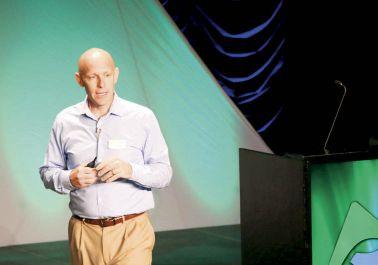
2 minute read
Conference previews 2017 technology trends

By Kayla Prasek
In 2017, the latest technology trends will continue becoming more readily available to the average technology user, according to Brett Anderson.
Anderson, a senior consultant and solution architect for Network Center Inc., gave an overview of the technology trends for the next year at NCI’s NVision 2016 conference Nov. 2 at the Avalon Events Center in Fargo. Among the trends he discussed were artificial intelligence, smart machines, augmented reality, virtual reality, 3-D printing, cloud and security.
“It’s interesting how artificial intelligence has evolved,” Anderson said. “If we combine artificial intelligence and automated machines, it’s a powerful combination.” An example of that is the Roomba vacuum.
Virtual reality, which is when a user is immersed into another world, also continues evolving, Anderson said. Samsung has started weaving virtual reality into its phones on a small scale, helping bring it to the masses, he said.
Augmented reality, which takes the space around the user and augments it, has also continued growing. Technology company Lenovo recently released a phone that has augmented reality built in with four cameras and can be used with games and for real world applications, Anderson said.
“There are endless possibilities for augmented reality,” he said. “Museums are starting to use it to bring the world alive around you. It could be used in retail to show how clothes work together.”
Another technology that keeps evolving is 3-D printing. “It’s evolving and becoming more practical,” Anderson said. “We’re seeing people making tables, chess pieces, gun parts. Health care is using it for a wide array of things as well.”
Anderson compared the evolution of 3-D printing to the evolution of computers. “Think about how computers grew over 10 years, and now think about what 3-D printing can become. This is moving down market and will be a bit more readily available to the masses.”
Anderson said in a few years, all these smart machines and applications will have practical uses as they move out of the early development stages.
Additionally, Anderson said “all our devices are meshing together to improve your world.” Many of those devices can be controlled by a smartphone.
“The mobile revolution is dead,” he said. “The mobile market has been slowing down and is saturated. It is no longer a revolution. Mobilization is here.”
Instead, Anderson said he advises clients to “do something disruptive” to help them stand out. One possibility to stand out is to have an app.
“A few years ago, mobile websites were important,” Anderson said. “We’re past that. Research has shown that customers spend four times as long with your business via an app than a mobile website.”
The cloud will continue to be important for holding data, which means both user experience and security will continue to be critical, Anderson said.
“When you start thinking about what you’re going to do to leverage mobile or doing something that will gather more data, security is the first thing you need to think about,” he said. PB










